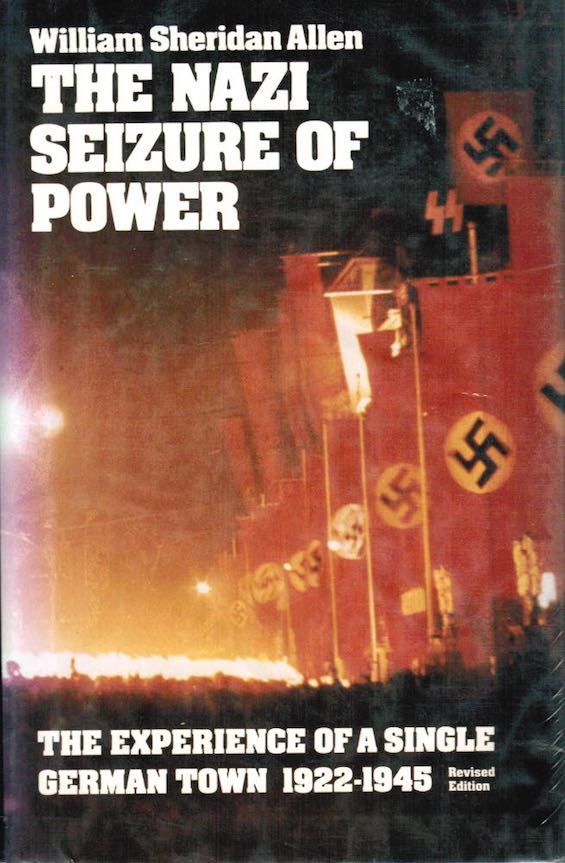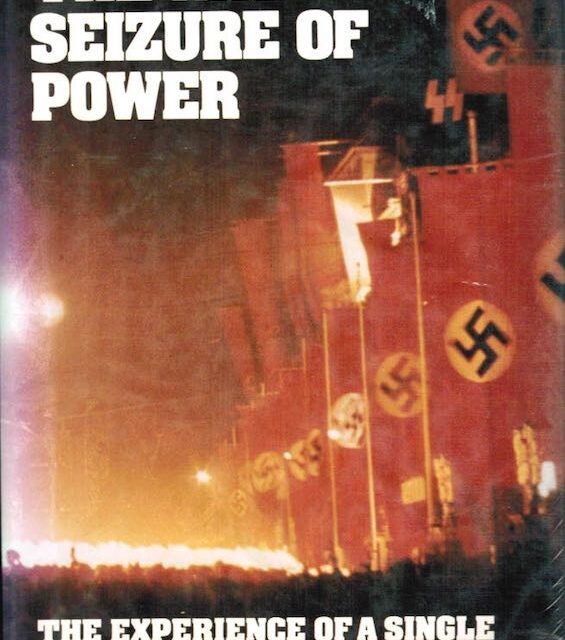
Estimated reading time: 6 minutes
Today, Northeim is a railroad town of some 29,000 people in northern Germany. But only about 10,000 called it home in 1930, when the Nazi Party began its explosive rise to dominance throughout the country. Historian William Sheridan Allen chose the town for his study at the local level of how Hitler’s minions succeeded in an alarmingly short time. His account, The Nazi Seizure of Power, spans the years 1922 to 1945. But the heart of the book—as reflected in the subtitle of the original, 1965 edition—covered the years 1930 to 1935. It was during that period when the tiny Right-Wing splinter group called the National Socialist German Workers’ Party (Nationalsozialistische Deutsche Arbeiterpartei) gained the support of nearly two-thirds of Northeim’s voters in three short years and then quickly moved to suppress all opposition.
How to explain the Nazi seizure of power?
Naturally, Allen’s aim in undertaking his study was to determine how the Nazis managed to crowd out all effective opposition in such a short time. His answer to the question appears pedestrian at first. “It was the depression, or more accurately, the fear of its continued effects, that contributed most heavily to the radicalization of Northeim’s people.” Which is unsurprising, as far as it goes.
But the author proceeds to qualify the statement. “Paradoxically,” he writes, “the workers remained steadfast in support of the status quo while the middle class, only marginally hurt by the economic constriction, turned to revolution.” In other words, class conflict lay at the heart of the Nazis’ success. The preponderance of German workers were members of the Socialist Party. And “it was [the middle class’s] hatred of the [Socialist Party] that drove Northeim into the arms of the Nazis. . . The attributes which made the Nazis respectable were their intense nationalism, their manipulation of religion, and the support given them by the conservatives,” i.e., the aristocrats and industrialists. If this analysis seems puzzling on its face, its accuracy becomes entirely clear in Allen’s history of the period.
The Nazi Seizure of Power: The Experience of a Single German Town, 1922-1945, Revised Edition by William Sheridan Allen (1983) 414 pages ★★★★☆

Violence became an everyday occurrence
Allen later goes on to write, “Orderly minded people were sickened by the recurrent fights [on Northeim’s streets], but finally become inured to them. Thus the way was paved for the systematic use of violence and terror by the Nazis after Hitler came to power, and for their relatively indifferent acceptance by the people of Northeim. This was to be the prime factor in the Nazi seizure of power.”
If you were assaulted, it would be “because you would deserve it”
To demonstrate how deeply the Nazis injected themselves into the life of the townspeople, Allen quotes from a letter the Nazi Local Group Leader and mayor “sent to a young woman in 1935. ‘It has been reported to me that on the occasion of the Führer’s birthday ceremony you did not raise your arm during the singing of the Horst Wessel song and the national anthem. I call your attention to the fact that by doing this you put yourself in danger of being physically assaulted. Nor would it be possible to protect you, because you would deserve it. It is singularly provocative when people still ostentatiously exclude themselves from our racial community by actions like yours. Heil Hitler!‘”
No Jews were killed in Northeim, and few went to concentration camps
Curiously, “there was hardly any manifest anti-Semitic action by the Nazis in Northeim during the last ten years of the Third Reich.” In 1930, at the outset of the period observed in Allen’s account, some 120 Jews lived in the town out of a total population of about 10,000, a proportion (one percent) that was roughly the same as that for Germany as a whole. But “by the time Hitler determined to murder all the Jews in his power, as his ‘Final Solution,'” Allen writes, “almost all of Northeim’s Jews had left the town for a bigger city and supposed anonymity, or had gone to another country for safety.
Northeimers did not harass their Jewish neighbors, but they also did their best not to ‘know’ what their government was doing to the Jews. By then, apathy and psychological denial had become a way of life.” Later, the author adds, “no one was killed, and very few were sent to a concentration camp from Northeim during the early years of the Nazi regime.”
An academic account that is often dull
I wish a journalist had written this book rather than a historian. The story would have been easier to read and more engaging if the author had related the town’s history through the lives of individual people. A few prominent names do surface throughout the book. The Leader of the Local Group of the Nazi Party who made himself mayor of the town throughout the years of the Third Reich. The local businessman who served as one of the town’s senators during the Weimar Republic and led opposition efforts during the Nazi takeover. And a senior civil servant who was, in effect, the town’s city manager. All three struck me as interesting enough to warrant portrayal in depth. But instead Allen merely referred to them again and again while describing the speeches, meetings, and marches that dominated the political process in the years 1930 to 1935.
About the author
William Sheridan Allen (1932-2013) retired in 2001 as professor of history at the State University of New York at Buffalo. The Nazi Seizure of Power, published in 1965, was his first book. But he made extensive revisions and additions to the text nearly two decades later, based on newly unearthed documentary sources. The book’s original subtitle was “The Experience of a Single German Town, 1930-1935,” but either he or his publisher rewrote it for the revised edition to encompass the full history of the Nazi Party in Germany.
For related reading
For a novel that casts light on some of these events from a contemporaneous Jewish perspective, see The Oppermanns by Lion Feuchtwanger (A German anti-Nazi novel published in 1933).
You might also enjoy:
- 10 top nonfiction books about World War II
- Good books about the Holocaust
- 7 common misconceptions about World War II
- 20 top nonfiction books about history
- Top 10 nonfiction books about politics
And you can always find my most popular reviews, and the most recent ones, on the Home Page.


























re: review of Explaining the Nazi seizure of power
Thank you for this review. Few in USA understand that these days much is similar in terms of public denial about the killing of millions of people both overseas and domestically* in our lifetimes.
* I refer to the war on poor people in USA, which likely kills over 100K/year due to pollution, lack of health care, and related causes.